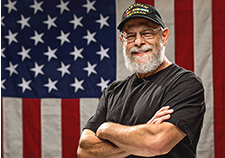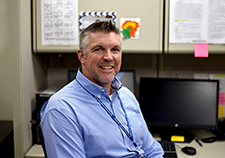Office of Research & Development |
 |


Some 2 million Veterans have used the Veterans Choice program to date to access care in the community. (Photo for illustrative purposes only. ©iStock/PabloBenitezLope)
December 4, 2018
By Mike Richman
VA Research Communications
In 2014, Congress passed a law that expanded access to health care for Veterans through a VA-funded, privately administered system. The measure, which came in response to reports of Veterans facing long wait times at VA medical centers and suffering possible adverse consequences, added to existing programs that allow former service members to receive care outside of VA.
The program is called the Veterans Choice Program. It stipulates that Veterans who need to wait more than 30 days to see a VA doctor or who live at least 40 miles from their closest VA site can receive health care from community providers. The provider must be part of VA’s network of community providers.
Some 2 million Veterans have used the Choice program to date.
Two VA studies that were published in July 2018 examined Veteran experiences with the program and reached similar conclusions (see sidebar): Patients generally liked the health care they received through the program, but they found the process challenging. They complained of a lack of community providers enrolled in the program, for example, and spoke of confusion in determining if VA or a third-party company is coordinating the care and is responsible for paying the bill.
"Community care as a business line in VA became very complex with the addition of Choice."
Dr. George Sayre of the VA Puget Sound Health Care System in Seattle led one of the studies, which included 43 Veterans, all but two of them male. Dr. Kristin Mattocks of the VA Central Western Massachusetts Healthcare System led the other study, which included 62 Veterans, all of them female. Her study was the first one, she says, to examine the challenges faced by women Veterans receiving care through the Choice program.
The participants in both studies told of their experiences through telephone interviews within about a year after the Choice program began.
Both VA and Congress have since worked hard to improve the program while listening to concerns from Veterans, community providers, and VA staff, says Dr. Kameron Matthews, VA’s acting deputy under secretary of health for community care.
“Before the law was passed that created the Veterans Choice Program, VA had several other community care programs,” Matthews says. “Community care as a business line in VA became very complex with the addition of Choice. VA knew it needed to work hard internally, and with our third-party administrators and with Congress, to make community care better for Veterans.”
“Since then,” she adds, “VA has taken steps to improve care coordination by introducing new processes and better technology to smooth out coordination between VA staff, community providers, and VA’s third-party administrators, such as TriWest Health Care Alliance. Billing issues have also been a problem, and VA is implementing new industry-standard processes to improve payment timeliness and to be a better partner to our community providers.”

VA ear surgeon studies management of severe hearing loss in Veterans

Veteran disability payments led to fewer hospitalizations

Air Force Veteran among 10 new awardees in VA diversity, equity, and inclusion research program

VA researcher leads project to evaluate Veteran screening for malnutrition
VA is transitioning to a new community care network (CCN) that is expected to greatly improve Veterans’ experiences with community care, especially with appointment scheduling. With CCN, VA facilities will schedule appointments with providers, instead of the Veteran having to go through a third-party company. Those companies will be required to pay claims to providers accurately and in a timely manner.
The addition of CCN addresses two of the main problems that Sayre and Mattocks found with the Choice program: appointment scheduling and providers getting paid on time.
Both researchers hope their findings will help influence implementation of the VA MISSION Act of 2018, a landmark bill President Trump signed into law earlier this year. The measure combines seven VA community care programs, including Choice, into one program to reduce the complexity in administering those programs and to make more efficient use of VA resources.
Currently, rules, processes, and requirements are different across the existing community care programs. That makes it hard for Veterans to distinguish one from the other and for community providers and VA staff to manage them all separately. VA and Congress agreed that combining the programs into one will lead to a smoother and more user-friendly operation.
The Choice program will remain intact until the VA MISSION Act is implemented. Currently, VA is developing regulations and policies, training staff, and awarding contracts in efforts to get the new program up and running. It’s supposed to be in place by June 2019.
In the words of President Trump, the VA MISSION Act creates some of the most substantial reforms to VA in a generation.
“This landmark legislation made Veterans Choice permanent, ensuring that our nation’s Veterans have timely access to the highest quality of care possible and the flexibility to receive care either at the VA or at a private health care facility,” the president said in a proclamation to mark Veteran’s Day in 2018. “The VA MISSION Act is removing barriers to telemedicine and expanding access to walk-in clinics. And it is giving Veterans who were catastrophically injured in World War II, the Korean War, the Vietnam War, and the Gulf War the same access to caregiver assistance that Veterans of more recent conflicts enjoy.”
In his study, Sayre wasn’t surprised that the Choice program improved provider access for some Veterans but also presented challenges. However, the degree and impact of the challenges was “striking,” he says.
“It’s widely known that Choice is a complicated program,” says Sayre, who is also an assistant clinical professor at the University of Washington. “Some of the broader lessons we learned from the Veterans are relevant and will hopefully inform implementation of the VA MISSION Act. That could mean the need for flexibility in determining when community care is preferable; Veteran challenges in understanding and navigating a complex system; the need for Veteran education and accessible support and resources for getting community care; and the importance of good coordination between VA and community providers for continuity of care.”
One of the biggest Veteran concerns in Mattocks’ study was the availability of community providers enrolled in VA’s network. Female Veterans may need to rely heavily on private health care because some of their gender-specific needs, including a mammography and maternity care, are not routinely provided at all VA facilities.
“For some types of care, such as obstetrics, there are very few obstetricians in certain parts of the country and even fewer if the obstetricians aren’t enrolled as Choice providers,” says Mattocks, who is also an associate professor at the University of Massachusetts. “The same is going to be true with the new community care program under the VA MISSION Act because most providers will still have to be enrolled in VA’s network of community providers, which are administered by the third-party companies. So perhaps some of the initial issues we experienced will get better, like scheduling and billing, but there will still be issues with provider availability in the community.”
Provider availability is the focus of Mattocks’ new $1.1 million VA research award, which is aimed at improving the relationship between VA and outside health facilities.

In studies, some Veterans who used the Choice program complained of poor communication between community-based health care providers and VA. (Photo for illustrative purposes only. ©copy;iStock/sturti)
The studies led by VA researchers Dr. George Sayre and Dr. Kristin Mattocks on the Veterans Choice Program both identified key themes that were based on Veterans’ opinions of the program. VA officials have been seeking such reactions. They hope the feedback, however critical it may sound, will help ease the process as the agency works to implement its new community care program under the VA MISSION Act, which replaces Choice and several other community care initiatives.
Sayre and Mattocks found that the Veterans who obtained care through the Veterans Choice Program had varied experiences in accessing it. Some of the Veterans received care for each service they sought. Others were treated for some services but were unable to obtain care for other conditions.
General impressions
The option of receiving care through Choice when VA services aren’t available was widely seen as a good idea, with one participant saying, “I’m glad to see they came up with [the program] … it captured my attention right away because I do live 90 miles away from service.”
However, most Veterans in both groups made a clear distinction between the concept of the Choice program and its implementation. “It’s a very well-intended, poorly orchestrated, not well-documented program,” one Veteran said.
Facilitators
The most common facilitator—a factor that made things work better— described by Choice care receivers was proactive VA providers and staff who handled the community care process for Veterans. But some of the recipients and most of those who were unsuccessful in using the Choice program voiced frustration with its requirement that a Veteran must go through VA to set up an appointment with an outside provider. Under the Choice program, Veterans must be authorized by VA to receive community care.
“If you can’t be seen by a VA doctor within 30 days, then you should automatically be able to go and find your own,” one Veteran said. “I think there needs to be something where … if I’ve done the research, I should be able to pick my doctor.”
Veterans can work with VA to pick the community provider they want. But in most cases, the provider must be in VA’s network, or there has to be an arrangement between VA and the community provider. VA believes it’s important that community providers caring for Veterans meet medical standards in the health care industry and be qualified to treat former service members.
Barriers to Accessing Care Through Choice
Many Veterans in both groups described the Choice process as quite complex and difficult to use, with one Veteran calling it a “horror story.” Often in describing their care process, participants couldn’t identify who they had talked to and sometimes had trouble differentiating between VA and third-party contractors: “Shouldn’t have to jump through hoops to get an appointment,” one Veteran said. “Just one person should be able to look at it and say, `He qualifies, let’s go.’”
Many Veterans in both groups also told of poor responsiveness by VA and third-party administrators, as well as lack of local providers. When VA’s new community care program is put in place next year, VA will do the scheduling, instead of the third-party companies.
Unintended Negative Impacts
For some participants, problems with Choice led to unintended consequences beyond the inability to access additional community care. Those consequences included an unexpected patient responsibility for costs of care, or receiving bills and having one’s access to care discontinued, with one participant saying his community-based specialty care was no longer covered after Choice was implemented.
“I had a doctor outside of VA who was taking care of everything,” one Veteran said. “Then all-of-a-sudden, mid-stream, the services were cut. I think it was due to the change in the program, so that’s when I had to go through VA and get that started again, which was an impossibility.”
Perceived Sources of Choice Problems
Veterans from both groups attributed shortcomings in the Choice program to several possible factors: the need for a learning curve on the part of the people running the program; inexperienced and incompetent staff; and larger political problems and issues intended to patronize Veterans.
“This program is a joke,” one participant said. “Maybe other people are having no problems with it, but as far as I’m concerned, it’s a joke. Just another one of those political mushrooms that the Obama administration, Democrats, Republicans, they toss it out just to pacify the Veterans. That’s all it is.”
The confusing aspects of the Choice program present a quandary, according to Sayre and his colleagues.
“The program’s complexity not only poses a barrier to accessing care, but also a challenge to identifying the sources of specific problems,” the researchers write. “Since most Veterans were unable to distinguish VA staff and providers from community providers and third-party staff, the challenges accessing Choice care were attributed to poor VA leadership and staff, even in cases in which the cause may be beyond the prerogative of VA leadership to solve.”
Eligibility information for Choice was limited and confusing
This stems largely from the fact that following the program’s initiation in 2014, nearly 9 million Veterans received Choice cards, although only 300,000 were initially eligible. Consequently, many Veterans thought they were eligible for additional services or could receive health care anywhere in the community without making an additional appointment.
“I’m not really sure how this works,” one Veteran said of her eligibility card. “If I can’t get into VA, does it mean I can go to another doctor?”
Women experienced difficulty scheduling appointments
Under the Choice program, all community providers must be enrolled before they can offer care. Plus, third-party administrators have largely been responsible for making appointments with enrolled providers on behalf of the Veterans (see main).
One Veteran hoping for a mammogram shared her frustrations working with Choice schedulers:
“I just called for the mammogram which, as far as I’m concerned, I received absolutely zero help from the Choice program. I [received] several messages garbled with no phone number, and the phone number that was given to me, I called and no one seemed to know which hand was, in fact, calling or responsible. Several times, I was [told], ‘Oh yeah, you know that fell through. I will talk to my supervisor or whoever, and we’re going to set this right.’”
Results were not shared with women Veterans or their VA providers in a timely manner
Many women were disappointed in the communication system between VA and community providers. Some participants spoke of their exasperation waiting for community care test results to be returned to VA, as well as the lack of knowledge of their VA providers with the community care the women had received.
“I never received a phone call even to let me know that the mammogram had come back not right, and that they needed further testing,” one participant said. “I eventually got a letter in the mail, and then I called VA back to get the diagnostic stuff set up. But I did not receive a call. So I just waited, hoping that maybe they were just overwhelmed.”
Concerns with unpaid bills were common
The participants experienced stress due to delayed payment of their community care bills. Some community providers, for instance, billed the Veterans for unpaid services. Late bills were eventually sent to collection agencies.
“My bills wind up going to collections because they’re not being paid,” one female Veteran said. “I don’t even know who I’m supposed to call to get them paid. I can’t pay them and request reimbursement. That part has been a nightmare.”
In the end, Mattocks believes the problems with the Choice program may stem from the fact that it was launched haphazardly.
“Because Congress mandated that Choice be implemented within 90 days, VA was responsible for developing, disseminating, and launching a massive new care delivery system over a period of three months,” she and her team write. “Consequently, many Veterans have experienced substantial challenges with Choice, including scheduling appointments, the payment of bills, and the lack of timeliness in the communication of results to VA providers.”
“As more Veterans use the Choice program, VA must design systems to ensure that Veteran care is coordinated between VA and non-VA systems of care,” the researchers add. “An ideal care coordination system would be one in which all Veterans’ community care, including scheduling, follow-up, communication with community providers, coordination of services, and transition back to VA care, is ensured.”
--- Mike Richman
VA Research Currents archives || Sign up for VA Research updates